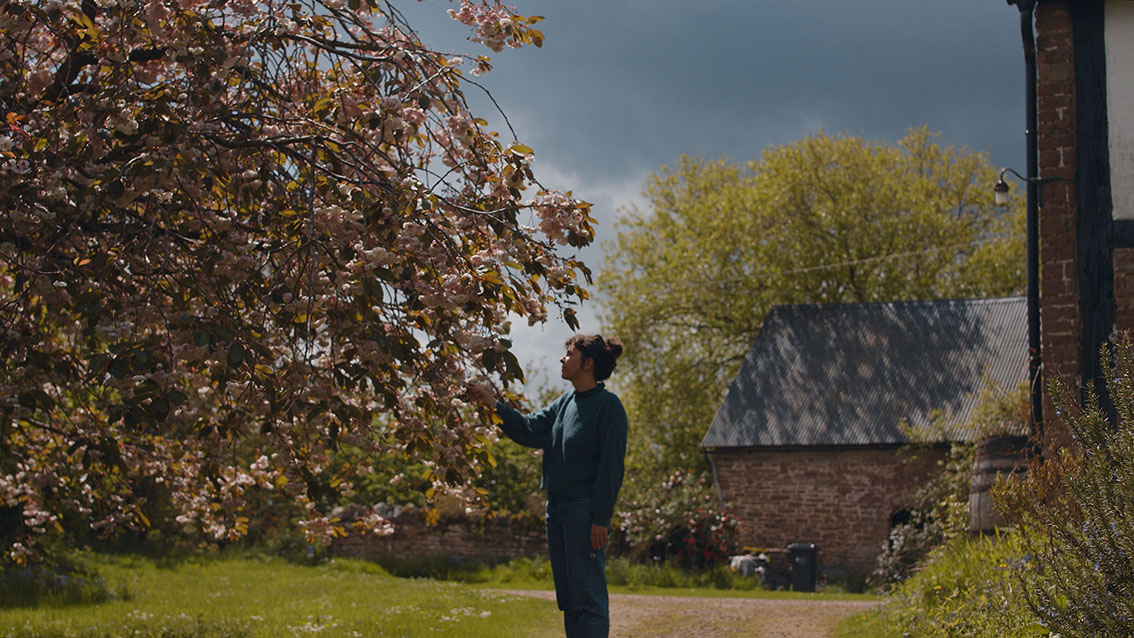Formed From Instinct by Nina Casson McGarva | An essay by Emma Park
13th July 2021
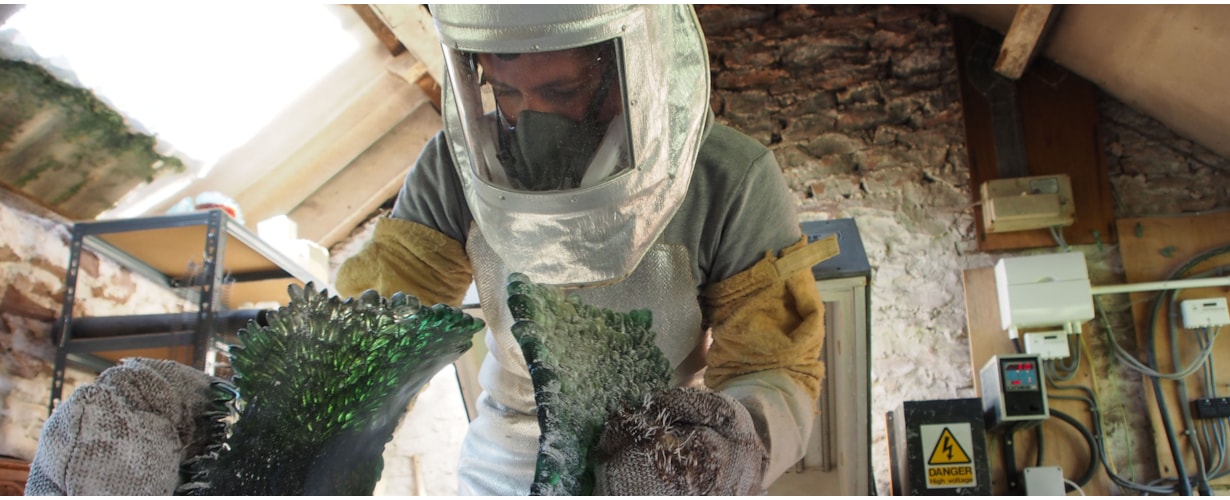
Formed From Instinct | A Solo exhibition by Nina Casson McGarva | 24 June – 27 August 2021 | An essay by Emma Park
In Nina Casson McGarva’s curling sculptures, glass is transformed from a heavy mass into glowing forms endowed with an ethereal motion. The rich, dappled combinations of colours draw on the tones of the natural world and recall the growth and decay of the seasons, as do their abstract, dynamic shapes. In Orange Rose, for example, both the two-toned palette and the gentle curves suggest the warmth and softness of a rose petal. In Autumn Cherry, the greens, browns and golds in a relatively upright form evoke the gradual withering of the leaves on a gnarled trunk.
The pieces in Formed From Instinct, Casson McGarva’s first solo exhibition, are the culmination of a technique and artistic vision that has taken her more than six years to develop. “She’s doing very complex, physical casting, in a way that I haven’t seen anyone do before,” says Angel Monzon, founder of Vessel Gallery, which has been representing her since 2019. “It’s really exciting – she’s inventing her own techniques.”
![]()
Orange Rose | Unique | H 15 cm W 55 cm D 43 cm | Cast and sculpted glass
If everything goes well, it takes Casson McGarva about two weeks to make one piece. Before embarking on a particular design, she will experiment with ideas in clay or wax. She will then make a large-scale model out of hundreds of bulging wax discs, moulding each in the palm of her hand. In size and heft they remind her, she says, of the velvety wisteria seed pods from the tree in her garden in rural Burgundy, where she grew up. She turns her ‘seeds’ into sculptures by an organic process that is a bit like cookery, a bit like bronze casting, and a bit like magic.
She encloses her completed wax model in an open-topped wooden crate, and pours a mixture of plaster and silica over the top. When this has hardened, she steams the wax out, leaving a mould. She spreads glass, ground or in billets, in her chosen colours over the top of the mould, and then fires it in the kiln until the glass has melted into the mould. The underside of the resulting piece will take on the texture of the ‘seeds’, while the top will be flat. She then breaks the mould off around the underside and cleans off the plaster. If necessary, she will cold-work the top to ensure a smooth and gleaming finish.
While kiln casting would usually stop there, Casson McGarva then adds a crucial extra stage. She puts the glass back onto a plaster powder and reheats it to 650 degrees Celsius, so as to soften it enough to make it bendable, without making it so hot that it starts to melt and lose its shape. She dons heat-resistant clothing and thick gloves, and takes the glass out of the kiln – almost as if she were making an extremely heavy pizza. She then bends the glass from a flat plane into a twisting, multi-dimensional form, with the ‘seeded’ surface on the outside and the smooth side inwards. “They’re so heavy, none of us understand how she does it,” says Monzon. Finally, she returns her creation to the annealer to cool down slowly.
After the careful process of kiln casting, the hot-working stage is “a big risk”, Casson McGarva says, because the glass will cool down and risk cracking after only a couple of minutes. “But I like the contrast between the control that I have at the kiln-forming stage, and the spontaneity of the hot-working, where I guide the material, but the thickness, colour, temperature and gravity all exert their own influence. Sometimes, my initial idea is realised in an unexpected way.” She estimates that she has made a hundred sculptures in total using this method, and has gradually refined it as she has learnt better how to guide the warm glass at the ‘bending’ stage. She describes herself as “very technically driven”; this is reflected in the craftsmanship of her works and their creativity with the medium.
The oval shape of the wax discs produce a mould that gives the glass a deep texture. This makes the resulting sculpture appeal to the sense of touch as well as sight, in a kinaesthetic way: looking at it, you can almost feel the ‘seeds’ massed over the surface. The boldness of this style reflects Casson McGarva’s upbringing: her grandparents, Mick and Sheila Casson, are potters, as is her father, Andrew McGarva, while her mother, Clare, is a textile artist. “I grew up around all these people that made things,” she says, “We always held the skills of the craftsman in high regard.” From an early age, she spent time in her father’s studio, throwing pots and modelling. She even earnt pocket money by selling little animals that she made out of clay. “They sold really well.”
After spending two years on woodworking, at seventeen, she enrolled in the École Nationale du Verre at the Lycée Jean Monnet. This institution is one of only two vocational schools in France where glassmaking can be studied professionally, usually as preparation for working in the crystal glass factories in the north-east. She spent four years there developing her technical skills in blowing glass. It was a chance conversation on a plane to Sweden that led to her enrolling at the Glass and Ceramics Workshop on Bornholm, part of the Royal Danish Academy of Fine Arts. Here, she was able to experiment creatively with the material in a way that had not been possible in France. She learnt new techniques such as kiln casting, which she studied with the British glass artist, Sally Fawkes.
![]()
Autumn Cherry | Unique | H 39 cm W 48 cm D 30 cm | Cast and sculpted glass
Upon graduating in 2014, Casson McGarva went to the USA to undertake residencies at Pilchuck Glass School and at STARworks Glass Lab, North Carolina. She spent three years in the country before moving to the UK in 2017 for the first time to work as an intern for Philip Baldwin and Monica Guggisberg, the renowned glass art duo, in their studio in Wales. There she practised cold-working techniques, in particular texturing. She then moved to Stroud, Gloucestershire, to work as assistant to Sally Fawkes in exchange for a day each week on her own projects. In 2019, she decided to settle in England for the long term, and has been there ever since. She rents a studio in Wobage Craft Farm Workshops, a craft community in the Wye Valley founded by her grandparents. At Wobage there are not only ceramicists but furniture makers, metal workers and basket weavers. She, however, is the first glass artist.
Like the rest of her family, Casson McGarva places great importance on making each of her sculptures herself. She sees her artistic process as a ‘cycle’ analogous to the cycles of nature; discoveries she makes while working on one sculpture may sow the seed of ideas for further pieces. “I am never out of ideas,” she says. Being able to work once again in a rural setting means she can walk outside her studio and observe the colours and substances of the changing seasons at first hand, before recreating them in glass. The distinctive shapes and surfaces of her sculptures are designed to recall the leaves, petals or feathers that are swept up by the wind at the end of a season, or pebbles washed over by the sea. In some pieces, such as Moment in the Cycle, there are even traces of black, suggesting the onset of organic decay. What the artist loves about glass as a material is its ‘minerality’ and way of creating translucent depth. The light seems to glow within her sculptures, as within quartz or jadeite.
The artist in her studio | Wobage Farm Craft Workshops
![]()
During a year of lockdowns, Casson McGarva made the best of things. Alone in her studio, she was able to continue working, without the distractions of socialising or travel. Artistically, she thrives on solitude. “I’m most productive when I can do my own thing and be in my own world.” In this isolation, her work developed, becoming larger and more ambitious – almost without her realising it. Formed from Instinct reveals a glassmaker whose work is both intuitive and reflective: the product of a creative instinct nurtured by tradition and refined by practice.
A still from Formed From Instinct | A Film by Nina Casson McGarvas
![]()
In Nina Casson McGarva’s curling sculptures, glass is transformed from a heavy mass into glowing forms endowed with an ethereal motion. The rich, dappled combinations of colours draw on the tones of the natural world and recall the growth and decay of the seasons, as do their abstract, dynamic shapes. In Orange Rose, for example, both the two-toned palette and the gentle curves suggest the warmth and softness of a rose petal. In Autumn Cherry, the greens, browns and golds in a relatively upright form evoke the gradual withering of the leaves on a gnarled trunk.
The pieces in Formed From Instinct, Casson McGarva’s first solo exhibition, are the culmination of a technique and artistic vision that has taken her more than six years to develop. “She’s doing very complex, physical casting, in a way that I haven’t seen anyone do before,” says Angel Monzon, founder of Vessel Gallery, which has been representing her since 2019. “It’s really exciting – she’s inventing her own techniques.”
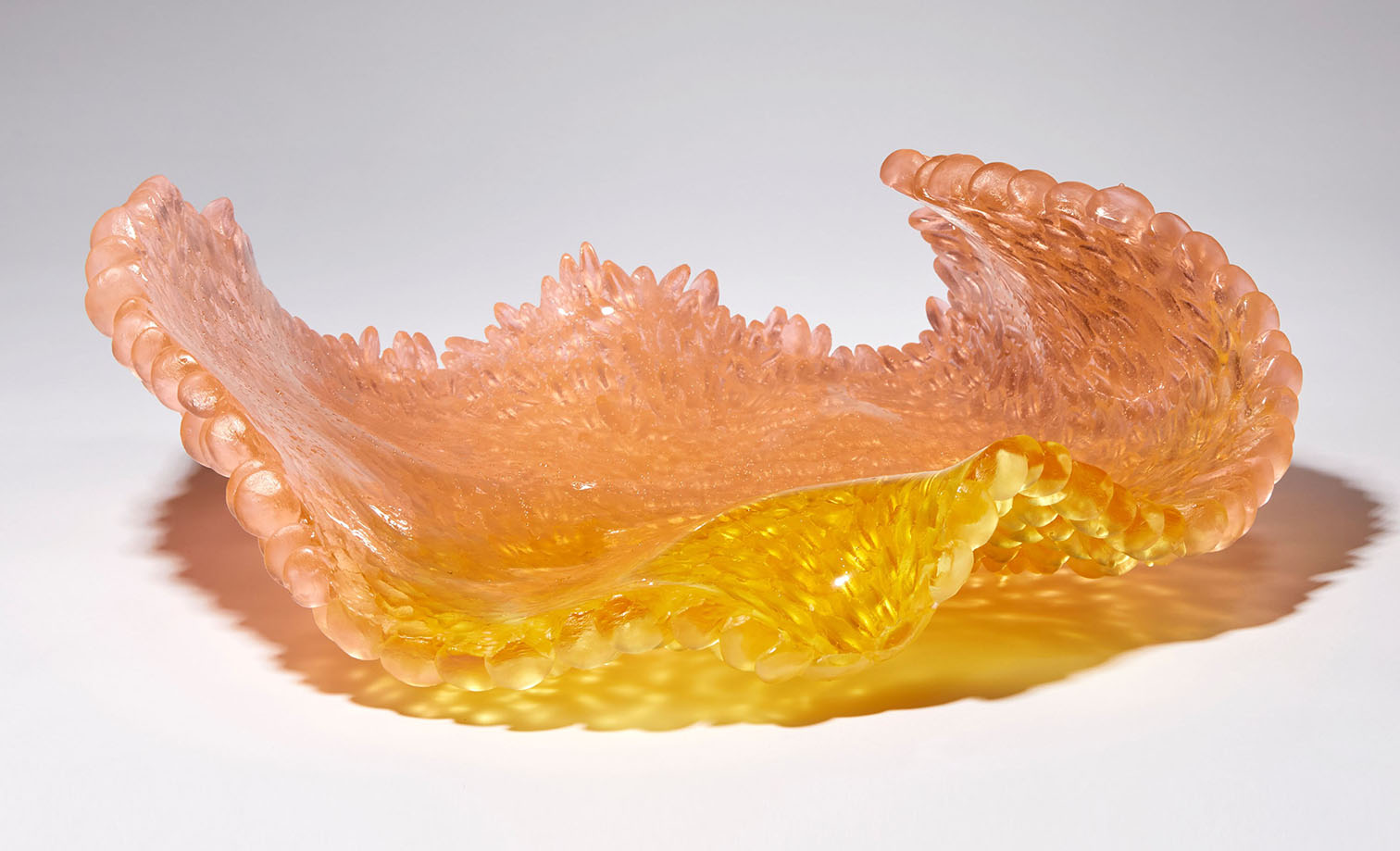
Orange Rose | Unique | H 15 cm W 55 cm D 43 cm | Cast and sculpted glass
If everything goes well, it takes Casson McGarva about two weeks to make one piece. Before embarking on a particular design, she will experiment with ideas in clay or wax. She will then make a large-scale model out of hundreds of bulging wax discs, moulding each in the palm of her hand. In size and heft they remind her, she says, of the velvety wisteria seed pods from the tree in her garden in rural Burgundy, where she grew up. She turns her ‘seeds’ into sculptures by an organic process that is a bit like cookery, a bit like bronze casting, and a bit like magic.
She encloses her completed wax model in an open-topped wooden crate, and pours a mixture of plaster and silica over the top. When this has hardened, she steams the wax out, leaving a mould. She spreads glass, ground or in billets, in her chosen colours over the top of the mould, and then fires it in the kiln until the glass has melted into the mould. The underside of the resulting piece will take on the texture of the ‘seeds’, while the top will be flat. She then breaks the mould off around the underside and cleans off the plaster. If necessary, she will cold-work the top to ensure a smooth and gleaming finish.
While kiln casting would usually stop there, Casson McGarva then adds a crucial extra stage. She puts the glass back onto a plaster powder and reheats it to 650 degrees Celsius, so as to soften it enough to make it bendable, without making it so hot that it starts to melt and lose its shape. She dons heat-resistant clothing and thick gloves, and takes the glass out of the kiln – almost as if she were making an extremely heavy pizza. She then bends the glass from a flat plane into a twisting, multi-dimensional form, with the ‘seeded’ surface on the outside and the smooth side inwards. “They’re so heavy, none of us understand how she does it,” says Monzon. Finally, she returns her creation to the annealer to cool down slowly.
After the careful process of kiln casting, the hot-working stage is “a big risk”, Casson McGarva says, because the glass will cool down and risk cracking after only a couple of minutes. “But I like the contrast between the control that I have at the kiln-forming stage, and the spontaneity of the hot-working, where I guide the material, but the thickness, colour, temperature and gravity all exert their own influence. Sometimes, my initial idea is realised in an unexpected way.” She estimates that she has made a hundred sculptures in total using this method, and has gradually refined it as she has learnt better how to guide the warm glass at the ‘bending’ stage. She describes herself as “very technically driven”; this is reflected in the craftsmanship of her works and their creativity with the medium.
The oval shape of the wax discs produce a mould that gives the glass a deep texture. This makes the resulting sculpture appeal to the sense of touch as well as sight, in a kinaesthetic way: looking at it, you can almost feel the ‘seeds’ massed over the surface. The boldness of this style reflects Casson McGarva’s upbringing: her grandparents, Mick and Sheila Casson, are potters, as is her father, Andrew McGarva, while her mother, Clare, is a textile artist. “I grew up around all these people that made things,” she says, “We always held the skills of the craftsman in high regard.” From an early age, she spent time in her father’s studio, throwing pots and modelling. She even earnt pocket money by selling little animals that she made out of clay. “They sold really well.”
After spending two years on woodworking, at seventeen, she enrolled in the École Nationale du Verre at the Lycée Jean Monnet. This institution is one of only two vocational schools in France where glassmaking can be studied professionally, usually as preparation for working in the crystal glass factories in the north-east. She spent four years there developing her technical skills in blowing glass. It was a chance conversation on a plane to Sweden that led to her enrolling at the Glass and Ceramics Workshop on Bornholm, part of the Royal Danish Academy of Fine Arts. Here, she was able to experiment creatively with the material in a way that had not been possible in France. She learnt new techniques such as kiln casting, which she studied with the British glass artist, Sally Fawkes.
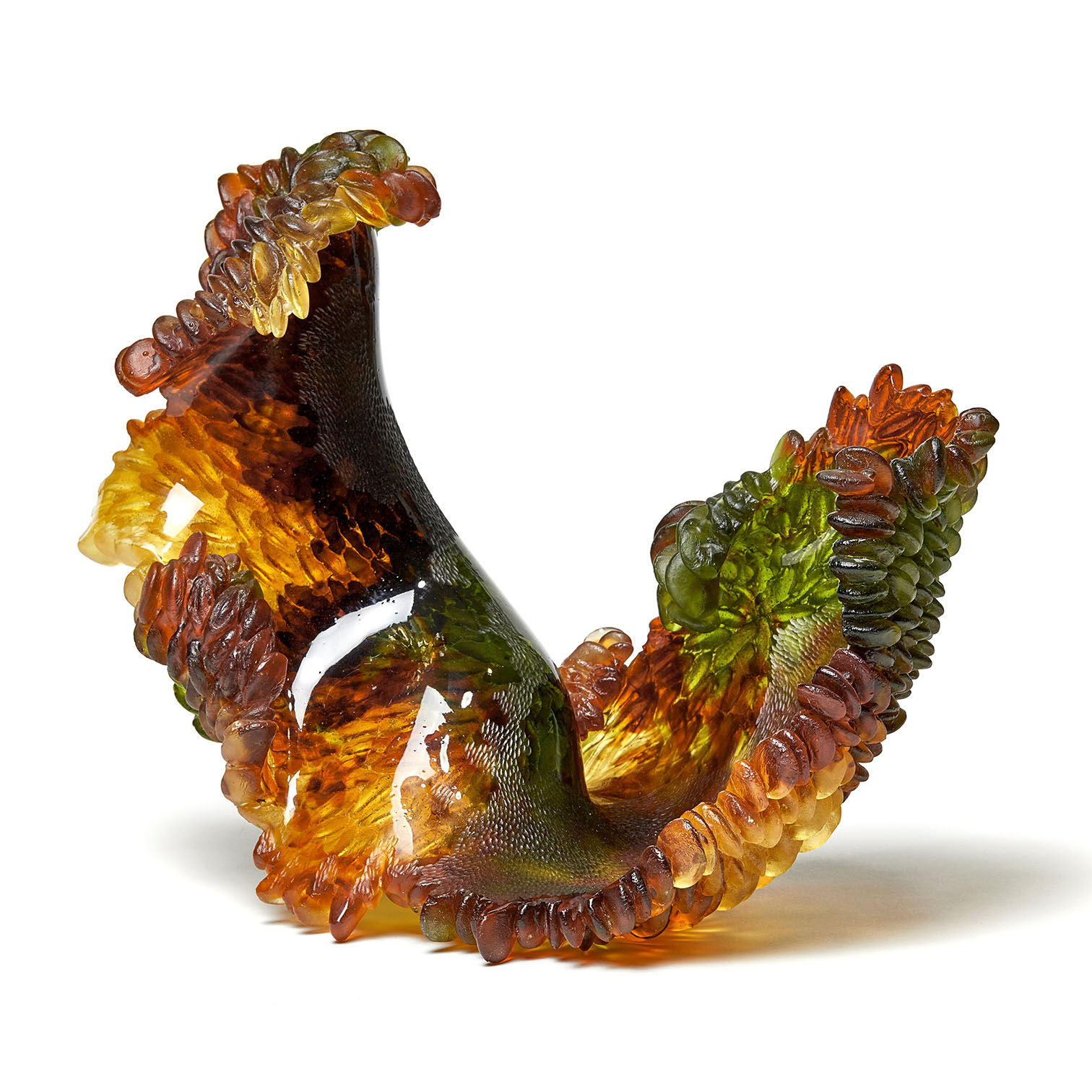
Autumn Cherry | Unique | H 39 cm W 48 cm D 30 cm | Cast and sculpted glass
Upon graduating in 2014, Casson McGarva went to the USA to undertake residencies at Pilchuck Glass School and at STARworks Glass Lab, North Carolina. She spent three years in the country before moving to the UK in 2017 for the first time to work as an intern for Philip Baldwin and Monica Guggisberg, the renowned glass art duo, in their studio in Wales. There she practised cold-working techniques, in particular texturing. She then moved to Stroud, Gloucestershire, to work as assistant to Sally Fawkes in exchange for a day each week on her own projects. In 2019, she decided to settle in England for the long term, and has been there ever since. She rents a studio in Wobage Craft Farm Workshops, a craft community in the Wye Valley founded by her grandparents. At Wobage there are not only ceramicists but furniture makers, metal workers and basket weavers. She, however, is the first glass artist.
Like the rest of her family, Casson McGarva places great importance on making each of her sculptures herself. She sees her artistic process as a ‘cycle’ analogous to the cycles of nature; discoveries she makes while working on one sculpture may sow the seed of ideas for further pieces. “I am never out of ideas,” she says. Being able to work once again in a rural setting means she can walk outside her studio and observe the colours and substances of the changing seasons at first hand, before recreating them in glass. The distinctive shapes and surfaces of her sculptures are designed to recall the leaves, petals or feathers that are swept up by the wind at the end of a season, or pebbles washed over by the sea. In some pieces, such as Moment in the Cycle, there are even traces of black, suggesting the onset of organic decay. What the artist loves about glass as a material is its ‘minerality’ and way of creating translucent depth. The light seems to glow within her sculptures, as within quartz or jadeite.
The artist in her studio | Wobage Farm Craft Workshops
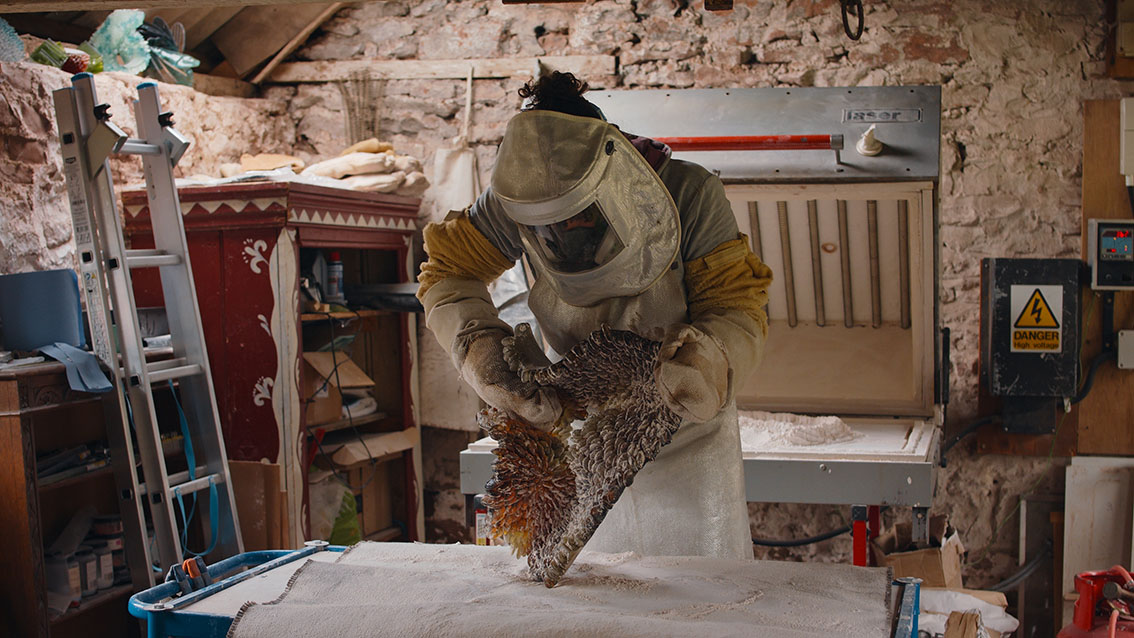
During a year of lockdowns, Casson McGarva made the best of things. Alone in her studio, she was able to continue working, without the distractions of socialising or travel. Artistically, she thrives on solitude. “I’m most productive when I can do my own thing and be in my own world.” In this isolation, her work developed, becoming larger and more ambitious – almost without her realising it. Formed from Instinct reveals a glassmaker whose work is both intuitive and reflective: the product of a creative instinct nurtured by tradition and refined by practice.
A still from Formed From Instinct | A Film by Nina Casson McGarvas
